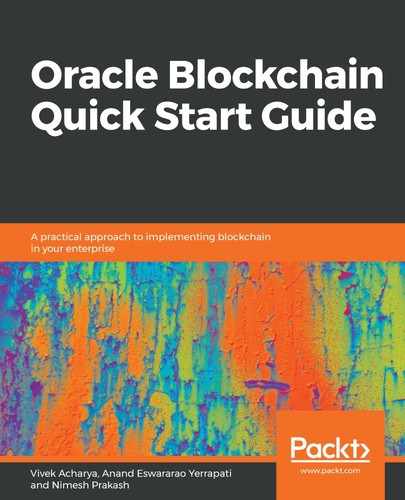BaaS offers a lot on top of its base (also known as its core). Hyperledger Fabric (base) is not preassembled. Hence, the enterprise needs to build chaincode and benefit from Hyperledger Fabric; they need to set up the Hyperledger Fabric infrastructure, handle its prerequisites, and configure and maintain it. The enterprise needs to ensure the integration of the installed Hyperledger Fabric environment with a security stake and manage the life cycle of all of the containers. The enterprise needs to handle the patching and upgrades and needs to ensure the system's huge availability, performance, business network management, and so on. Oracle's blockchain platform is based on Hyperledger Fabric. With OBP, the enterprise's responsibilities to set up, manage, and maintain the blockchain platform will shift toward Oracle (BaaS provider), and the enterprise can continue to focus on building work class blockchain applications and solutions.
Linux foundation's Hyperledger Fabric is the foundational base (core) for OBP. With Hyperledger Fabric being the base, any vendor (including Oracle) offering solutions on top of it must automatically adhere to industry standards. Blockchain platforms, such as Oracle's Blockchain platform, ease the creation of a network where participants from different organizations can participate and work together. Interoperability challenges such as governance, naming convention standards, and unified data models need to meet common consensus. For example, a consortium where participants mutually agree on standards, rules of participation, sharing of cost and profits, governance mechanism, and collective risk mitigation, along with the inclusion of analytics, auditing, and validation to ensure smooth blockchain network operations.
OBP offers a console to manage networks, channels, and users. It offers a REST proxy and various other infrastructure services to set up, build, and maintain a blockchain network. It's built on top of Hyperledger Fabric and adds a lot of rich features to allow for the ease of operations, enhanced security, and high accessibility. Oracle OBP is a BaaS offering from Oracle, which has the potential to address enterprise DLT/blockchain use cases. The Oracle offering includes infrastructure services and various embedded resources such as compute, containers, storage, event streaming, and identity management. Oracle has the following features:
- Standard-based: Oracle BaaS's core is Hyperledger Fabric; hence, it automatically adheres to industry standards. As a result, applications built on OBP are interoperable and compatible. This feature matches the BaaS qualifier standard listed in the previous section.
- Preassembled: Oracle's blockchain platform includes a preassembled identity solution (Oracle's identity management), object store (embedded archiving), and RESTful APIs. The Oracle offering includes an operational console to configure and manage the entire blockchain business network. Onboarding of B2B partners to the blockchain network is simplified and partners can be verified with a built-in identity solution. This feature resembles the BaaS qualifiers: quick setup, security, privacy, and chaincode management and monitoring.
- Pluggable: It offers integration services with Oracle Integration Cloud Service (OICS), which allows for quick integration with SaaS and PaaS applications. This feature fits into the BaaS qualifier integration and other services, which are as follows:
- The enterprise can leverage OICS tools in order to process cloud services to build and extend BPM (workflow) applications. The enterprise can extend its SaaS applications using SDKs or RESTful APIs.
- Applications built on the Oracle development platform (for example, VBCS) can invoke operations on chaincode using various standards (Java, Node.js, and Go) and APIs.
- Enterprises can build applications on application container cloud services, Java cloud services, mobile cloud services, or application builder cloud services and can initiate blockchain transactions using SOA cloud services, process cloud services, and APIs.
- Enterprise-grade solution: It is a managed service with high availability, enhanced security, and continuous backup of ledgers. This feature resonates with the BaaS qualifier—resilience.
- Automated: Oracle's autonomous database anchors OBP. Hence, it leverages the benefits of Oracle's autonomous database, such as self-provisioning, auto upgrades, enhanced security, and monitoring. It auto-applies security patches without a downtime, enhancing security multifold and storing data in an encrypted state. It offers self-repairing features, which ensures the highest availability and reduces planned and unplanned downtime to less than two and a half minutes. This feature fits into the resilience and monitoring BaaS qualifiers.
- Privacy: Hyperledger Fabric offers channels and private data collection (refer to Chapter 3, Delving into Hyperledger Fabric for more details) to allow the enterprise to conduct confidential transactions. The Oracle offering allows only approved peers to join channels. This feature fits with the security and privacy BaaS qualifiers.
While analyzing the blockchain solution, identifying the use cases, and choosing the most relevant blockchain platform, it's strategically important to look at the core systems, business processes, and benefits the enterprise will reap from the inclusion of blockchain in your ecosystem. We are in an era of cloudifying (cloud) infrastructure, applications, and processes. Blockchain cloud platform is an excellent addition to your cloud strategy. Cloud and blockchain strategies go hand in hand with a vision toward the future of autonomous organizations. This book contains details and practices around Hyperledger Fabric and its realization though Oracle's blockchain cloud platform. We will be going though this in detail in subsequent chapters.
